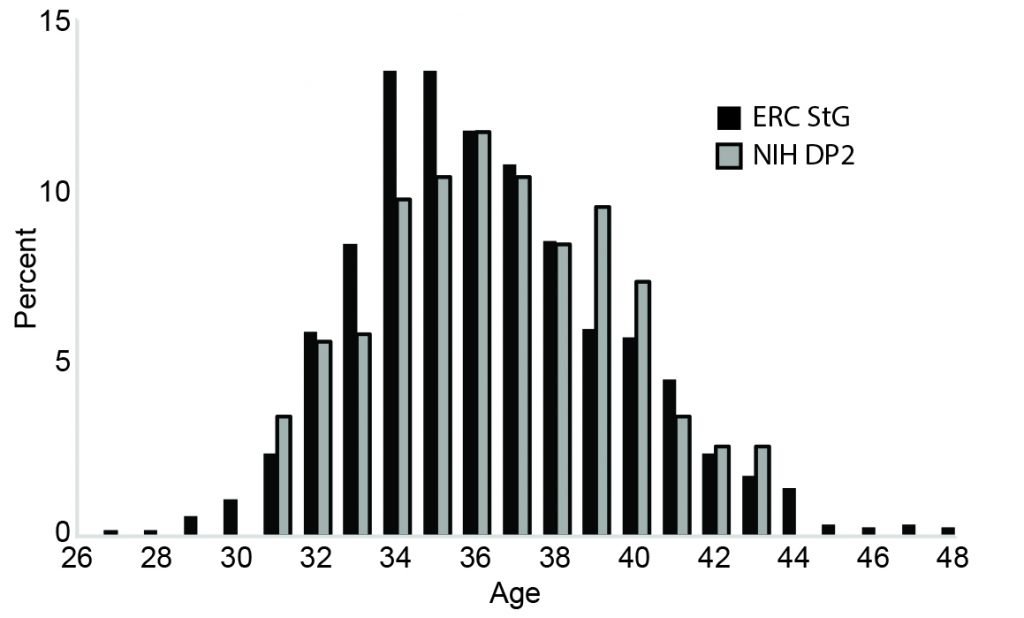Today, members of Rescuing Biomedical Research published an article in Science proposing the expansion of the National Institutes of Health’s New Innovator (DP2) award. The DP2 award is available only to early-stage investigators and places an emphasis on novel scientific ideas without requiring significant preliminary data. The DP2 program has received a positive evaluation, and we recommend this program be scaled up to support the careers of emerging scientists.
Below is an expansion of a few topics touched on in the article:
The DP2 program launches careers at relatively early ages (Figure). The small cohort of researchers receiving DP2 awards began their independent careers at a median age of 36 years, in contrast to 44 years for R01 awardees. Notably, the age distribution for DP2 recipients is similar to that observed for recipients of the European Research Council’s Starting Grants in the life sciences, for which the median age has been 35 years. Thus, greatly expanding the number of DP2 grants would both stimulate novelty and could help reduce the age at which young PIs achieve independence.

The age distribution of recipients of ERC StGs in life sciences compared with the age distribution of recipients of the NIH DP2 awards. ERC data were provided courtesy of Jose Labastida, head of the ERC Scientific Department. NIH data were obtained by a FOIA request. Values for DP2 PIs 30 and younger and 44 and older were not provided by the NIH due to privacy concerns.
—
We propose expanding the DP2 program in a step-wise fashion from roughly 50 grants per year to over 500, and we caution that any bias in awarding grants should be monitored and minimized. Failure to identify and understand possible underlying biases in grant decisions could propagate those biases as the program expands.
The NIH’s R01 program appears to have biases against applicants based on gender, race and geography. The DP2 program is younger and smaller than the R01 program, and an analysis of applicants and awardees indicate the percentages of minorities and women in the DP2 finalist and awardee pools closely reflect the percentage of each in the applicant pool. Thus, there is no direct evidence of bias against minorities and women in selecting DP2 finalists and awardees. How bias might affect other aspects of the process, such as in how applications are solicited, should be explored.
Biases potentially affecting awards should be closely tracked as the DP2 program expands. Additionally, because the DP2 awards are made once yearly, the NIH could potentially analyze and respond to biased awarding of grants from one grant cycle to the next.
—
Expanding the DP2 program to 550 awards annually will require the NIH to increase the funds for the program. We proposed a step-wise increase in DP2 awards, ideally completing its expansion in a five-year period. At the five-year point, 550 DP2 awards would cost approximately $1.33 billion (550 awards at 2017 average DP2 total cost – $2,425,524. Reference for average DP2 size: https://projectreporter.nih.gov/reporter.cfm searched for 2017 type 1 DP2 awards)
The NIH is expecting to fund nearly 1,100 R01s for early-stage investigators at the end of their Next Generation Researchers initiative. Converting half of these R01s to DP2 awards would provide $265 million for the program (550 R01s at the 2017 average R01 total cost – $482,395. Reference for average R01 size: https://bit.ly/2G7wqBC ).
The NIH has pledged roughly $1.1 billion in additional funding for young investigators through their NGRI program. This $1.1 billion plus the $265 million from converting ESI R01s into DP2 awards provides $1.365 billion for the program, enough to cover the cost of 550 annual DP2 awards.
